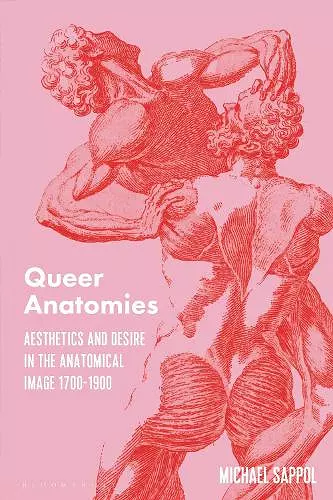Queer Anatomies
Aesthetics and Desire in the Anatomical Image, 1700-1900
Format:Paperback
Publisher:Bloomsbury Publishing PLC
Published:17th Oct '24
Should be back in stock very soon

Explores the possibilities of concealed eroticism in anatomical drawings of the 18th and 19th centuries. Includes detailed analysis of text and images and explores the lives of the men who drew these illustrations, and those who used and collected them.
In centuries past, sexual body-parts and same-sex desire were unmentionables debarred from polite conversation and printed discourse. Yet one scientific discipline—anatomy—had license to represent and narrate the intimate details of the human body—anus and genitals included. Figured within the frame of an anatomical plate, presentations of dissected bodies and body-parts were often soberly technical. But just as often monstrous, provocative, flirtatious, theatrical, beautiful, and even sensual. Queer Anatomies explores overlooked examples of erotic expression within 18th and 19th-century anatomical imagery. It uncovers the subtle eroticism of certain anatomical illustrations, and the queerness of the men who made, used and collected them.
As a foundational subject for physicians, surgeons and artists in 18th- and 19th-century Europe, anatomy was a privileged, male-dominated domain. Artistic and medical competence depended on a deep knowledge of anatomy and offered cultural legitimacy, healing authority, and aesthetic discernment to those who practiced it. The anatomical image could serve as a virtual queer space, a private or shared closet, or a men’s club. Serious anatomical subjects were charged with erotic, often homoerotic, undertones.
Taking brilliant works by Gautier Dagoty, William Cheselden, and Joseph Maclise, and many others, Queer Anatomies assembles a lost archive of queer expression—115 illustrations, in full-colour reproduction—that range from images of nudes, dissected bodies, penises, vaginas, rectums, hands, faces, and skin, to scenes of male viewers gazing upon works of art governed by anatomical principles. Yet the men who produced and savored illustrated anatomies were reticent, closeted. Diving into these textual and representational spaces via essayistic reflection, Queer Anatomies decodes their words and images, even their silences. With a range of close readings and comparison of key images, this book unearths the connections between medical history, connoisseurship, queer studies, and art history and the understudied relationship between anatomy and desire.
Deeply researched and beautifully illustrated … a must read for anyone interested in medical humanities, the visual culture of anatomy and medicine, history of book illustration, history of collecting, queer theory, and/or esthetics. * Social History of Medicine *
Gay physicians and aesthetes of all stripes will enjoy Sappol's chatty style, peppered with winking asides, and appreciate his deep scholarship and intimate familiarity with anatomical art. * Gay & Lesbian Review *
Queer Anatomies upends all that we know and assume about the dissected body, the male gaze, and the interior life of early anatomists. Michael Sappol is erudite and learned, clever and brash, always surprising, and consistently brilliant. * Mary Roach, author of Stiff: The Curious Lives of Human Cadavers (2004) *
Rethinking ‘queerness’ through the historical lens of artistic anatomy, Michael Sappol opens the closet on the lushly erotic, macabre—queer—pleasures in exquisite prints of dissected bodies. Wearing its erudition lightly, Sappol’s witty take in Queer Anatomies informs, delights and challenges in equal measure. * Anthea Callen, Professor of Art, Australian National University, Australia *
Lavish, provocative, and richly revealing, this is a visually dazzling and intellectually playful meditation on the transgressive culture of 18th- and 19th-century anatomical illustrations and the men who created, scrutinized, and collected them. * John Warner, Professor of History, American Studies, and History of Science and Medicine, Yale University, USA *
Michael Sappol looks at what others ignore, teasing out the places where scholarship and sexuality, medicine and pleasure meet. This exquisitely researched, beautifully written and illustrated book will provoke, fascinate, and delight. * Joanna Ebenstein, Founder of Morbid Anatomy, author of Anatomica: The Exquisite and Unsettling Art of Human Anatomy (2020) *
ISBN: 9781350400870
Dimensions: 232mm x 156mm x 22mm
Weight: 620g
280 pages